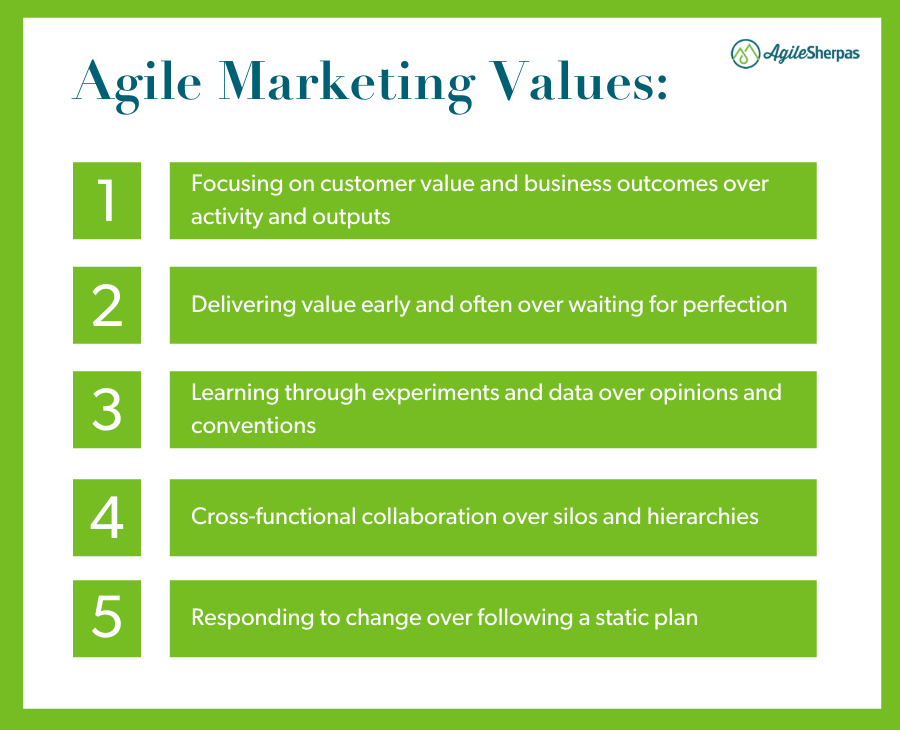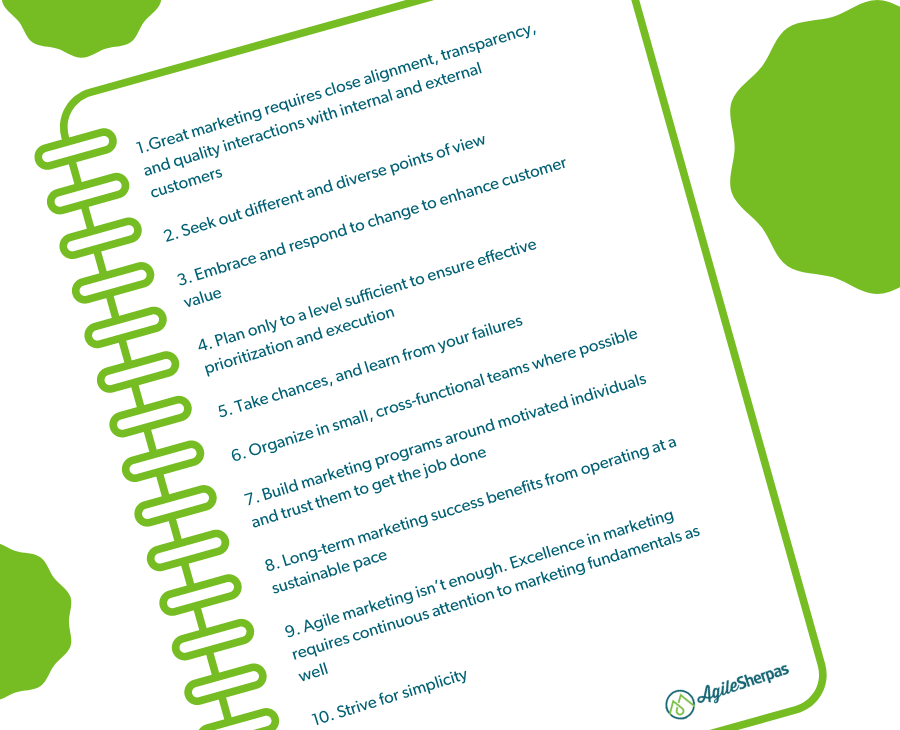-
- marketing agility
- Teams
- Organizations
- Education
- enterprise
- Articles
- Individuals
- Transformation
- Solution
- Leadership
- Getting Started
- business agility
- agile management
- going agile
- Frameworks
- agile mindset
- Agile Marketing Tools
- agile marketing journey
- organizational alignment
- Agile Marketers
- People
- Selection
- (Featured Posts)
- strategy
- agile journey
- Metrics and Data
- Kanban
- Resources
- Why Agile Marketing
- agile project management
- self-managing team
- Meetings
- Scrum
- agile adoption
- scaled agile marketing
- tactics
- scaled agile
- AI
- Agile Meetings
- agile marketing training
- agile takeaways
- Agile Leadership
- agile coach
- enterprise marketing agility
- Scrumban
- state of agile marketing
- team empowerment
- Intermediate
- agile marketing mindset
- agile marketing planning
- agile plan
- Individual
- Team
- Videos
- agile marketing
- kanban board
- Agile Marketing Terms
- agile transformation
- traditional marketing
- FAQ
- agile teams
- Agile Marketing Glossary
- CoE
- Scrumban
- agile
- agile marketer
- agile marketing case study
- agile marketing coaching
- agile marketing leaders
- agile marketing methodologies
- agile marketing metrics
- agile pilot
- agile sales
- agile team
- agile work breakdown
- cycle time
- employee satisfaction
- marketing value stream
- marketing-analytics
- remote teams
- sprints
- throughput
- work breakdown structure
- News
- agile brand
- agile marketing books
- agile marketing pilot
- agile marketing transformation
- agile review process
- agile team charter
- cost of delay
- hybrid framework
- pdca
- remote working
- scrum master
- stable agile teams
- stand ups
- startups
- team charter
- team morale
- user story
- value stream mapping
- visual workflow

In 2012, a group of enthusiastic senior marketers put together the first Agile Marketing Manifesto. It took Agile methodologies and reworked them specifically for busy marketers. The Manifesto directs marketing teams on how to embody the agility mindset in their ways of working.
Since then, the field of Agile marketing has substantially grown and evolved. According to the Annual State of Agile Marketing report, over half of marketers that responded labeled themselves as Agile.
For over five years, that adoption rate has been increasing steadily. As marketers discover new ways of applying Agile to their work, Agile is maturing as well. As marketing has evolved, the ways marketers use Agile have evolved along with it. That’s why we needed to revisit and update the Agile marketing principles and values set nearly 10 years ago.
For this purpose, in September 2021, we held the virtual event SprintTwo. The main objective of the virtual gathering was to bring Agile marketing practitioners together to finalize and announce the updated manifesto.
The participants that gathered shaped the future of Agile marketing by updating the existing version and adapting it to the current state of agility in marketing.
The update of the Agile Marketing Manifesto had two stages: a survey, and a virtual event to iterate on the updated version and findings from the survey.
The survey represented the initial step of the process as it allowed marketers to share their thoughts and vision of the current state of the manifesto and which elements called for attention ahead of the live event.
On the first day of the event, attendees analyzed the input from the survey. Then, subsequent sessions brought qualified marketers together to complete the first phase of work. By the end of the event, the proposed changes that were formulated by the SprintTwo Leadership Group were updated and accepted by the community of Agile marketers.
In October 2021, both the Agile marketing values and principles were successfully refreshed on the official digital home of the manifesto. Now let's explore the new updates, and learn how you can use them to improve the way you do Agile with your marketing team.
The update of the Agile Marketing Manifesto had two stages: a survey and a virtual event to iterate on the updated version and findings from the survey.
The survey represented the initial step of the process as it allowed marketers to share their thoughts and vision of the current state of the manifesto and which elements called for attention ahead of the live event.
On the first day of the event, participants analyzed input from the survey. The sessions brought qualified marketers together to work on the completion of the manifesto. The proposed changes were formulated by the SprintTwo Leadership Group and accepted by the community of Agile marketers.
In October 2021, both the Agile marketing values and principles were successfully refreshed on the official digital home of the manifesto. Now let's see the new updates and learn how you can improve how you do Agile with your marketing team.
Values Update
According to both the original Agile Manifesto for software development and the marketing version, values emerge as a profession evolves.
The values from the Agile Marketing Manifesto were revised and updated to better reflect the concept of agility. In addition, they were slimmed down from the original seven to five for ease of application. Let’s take a look at what’s changed.

Focusing on customer value and business outcomes over activity and outputs
The first value is one of the new additions to the refreshed version of the manifesto for marketers. Many marketers fall into the trap of delivering marketing programs just for the sake of delivering marketing programs.
However, it’s about doing the right things, not just more things. You can work smarter, not harder, and still prioritize customers by delivering impactful campaigns that exceed expectations. Planning those campaigns is more effective when the plan is based on outcomes, instead of outputs.
Delivering value early and often over waiting for perfection
Marketers that seek perfection often take the big bang approach and suffer the wrath of long production times.
This value was born from these two forerunner values – “Adaptive and iterative campaigns over Big-Bang campaigns” and “Customer-focused collaboration over silos and hierarchy”.
Focusing on early delivery and customer value tends to be less risky than the “Go big or go home” approach, it’s less resourceful and actually improves customer relationships.
Rather than waiting, delivering early in the cycle means that we can achieve more by getting feedback earlier and more frequently in order to improve.
Learning through experiments and data over opinions and conventions
Experiments allow us to learn more quickly and efficiently. Based on metrics, we can make more effective and meaningful decisions about what the final versions of our campaigns look like.
Ignoring data or relying on assumptions wastes valuable time and resources and doesn’t result in the best outcome for our customers. Validated conversations and opinions are based on real experimentation and measurements, not on guessing.
This value relates very much to its predecessor – “The process of customer discovery over static prediction”. If we look at our campaigns as a learning experience centered around the customer, we can gain a better comprehension of the audience we’re communicating with. This is a big contrast to older approaches that made a grand prediction and stuck by it, no matter what.
Cross-functional collaboration over silos and hierarchies
Teams that are designed to be cross-functional are centered around the customer and produce better marketing results than silo structured organizations.
Silos prevent knowledge from spreading. This means that what is discovered by one team or individual doesn’t get shared with others, either overcomplicating the process of continuous improvement or stalling it out entirely because each team has to learn independently.
Responding to change over following a static plan
The slight change in this value adds the word 'static'. Teams that stick to plans and ignore all the red flags along the way are destined for lousy marketing outcomes.
We must be able to diverge from rigid planning and be adaptive when changes arise or we jeopardize the success of connecting with the audience and delivering the value they expect.
Principles Update
The Agile marketing principles are based on values. They emphasize the details that form a truly Agile team. The principles are simple and very much self-explanatory.
In October, many of the attendees from SprintTwo gathered to finalize the refreshed principles that further clarify the values. Let’s take a look.

Great marketing requires close alignment, transparency, and quality interactions with internal and external customers
Before: Great marketing requires close alignment with the business people, sales, and development.
Communication, visibility, and transparency are pillars of a successful Agile marketing team. Shared planning and interactions with stakeholders, as well as internal and external customers, help reduce risks and conflicts while increasing team morale.
Seek out different and diverse points of view
This principle is new to the list. It refers to not limiting yourself to objective truths. In a creative, Agile process, reaching out to individuals, even from different departments, to give you a fresh perspective, is encouraged.
When you seek opinions from the right places, more team collaboration is fostered, which allows a more varied approach to regular, recurring campaigns.
Embrace and respond to change to enhance customer value
Before: Our highest priority is to satisfy the customer through early and continuous delivery of marketing that solves problems.
This updated principle strongly emphasizes the path to value creation that, ultimately, ends at the hands of the customer. It speaks to the fact that in order to truly satisfy our customers, we need to not just provide value, but provide it regularly and sustainably, without fail. Only in this way can we elicit customer satisfaction and, in turn, customer trust.
Plan only to a level sufficient to ensure effective prioritization and execution
Before: We welcome and plan for change. We believe that our ability to quickly respond to change is a source of competitive advantage.
The refreshed version of this principle reminds us to plan just enough. In other words, remain flexible in our planning approach. Strict plans are overrated and unsustainable when it comes to high-quality execution and prioritization. Plan to a point when you know the outcome will be reached successfully without getting into too much detail.
Take chances, and learn from your failures
Before: Don’t be afraid to fail; just don’t fail the same way twice.
Here, the change from the original is not major but encourages teams to deep dive into opportunities, even if they fail.
There can be lessons learned in every failure. This Agile marketing principle invites contributors to get out of their comfort zones and experiment. No matter how big of a flop the outcome may be, your team will certainly gain new perspectives and improve in the future.
Organize in small, cross-functional teams where possible
Another principle that is newly added but holds the concept of creating greater value through collaboration and cross-functionality.
All you need is a small team that subscribes to the Agile mindset with substantial skills to lead from strategy to execution.
Build marketing programs around motivated individuals and trust them to get the job done
Before: Build marketing programs around motivated individuals. Give them the environment and support they need, and trust them to get the job done.
Agile marketing is a team sport, but it relies on qualified, committed individuals having the freedom to succeed in their endeavors. In an Agile environment, leaders are encouraged to curb their urges to micro-manage and, instead, serve as an enabler, allowing their team members to own the execution of their work.
Long-term marketing success benefits from operating at a sustainable pace
Before: Sustainable marketing requires you to keep a constant pace and pipeline.
Despite the typical language surrounding the Scrum framework, Agile is actually not a sprint, it’s a series of sprints that can be considered a marathon.
Going as fast as you possibly can, won’t necessarily reap the best long-term results in an Agile process. However, building sustainable pace with your team, will.
Agile marketing isn’t enough. Excellence in marketing requires continuous attention to marketing fundamentals as well
Before: Continuous attention to marketing fundamentals and good design enhances agility.
The new phrasing of this principle aims to drive home the fact that great results do now stem from an Agile process alone. In truth, we need solid marketing foundations and proven best practices to help us produce quality marketing work and an Agile process to help us do it with the customer in mind, in the most effective way possible.
Strive for simplicity
This golden principle remains unchanged. Focus on flow and eliminate waste for greater efficiency in the marketing process. By simplifying the workflow and limiting the number of projects we’re working on, we remove a part of the complexity that is often legacy, especially in large organizations.
The Ongoing Evolution of Agility
As the Agile marketing adoption rate rises, marketers benefit from staying up to date with the principles and values that drive the methodology and make it so successful for our function.
As Agile marketing teams mature and discover more about how this methodology affects the marketing process in different ways, we anticipate even more updates to the manifesto in the future.
Now, marketers have the responsibility to lead by example and inspire other industries to cross the gate to agility and grow the community even further. The constantly changing Agile landscape hints that the best is yet to come.
What do you think about the updates?
Topics discussed
Improve your Marketing Ops every week
Subscribe to our blog to get insights sent directly to your inbox.


